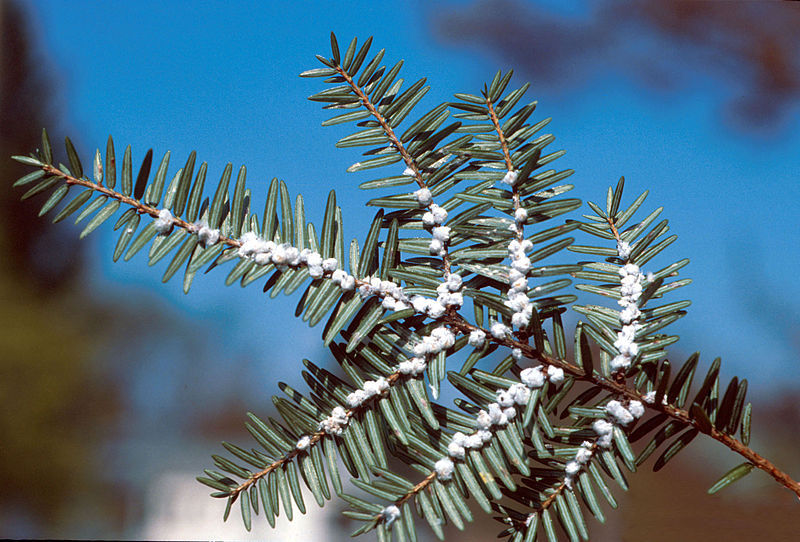Eastern Hemlock : Is the eastern hemlock in danger?
The Hemlock woolly adelgid (Adelges tsugae) poses a huge threat to the eastern hemlock tree. It is a bug native to East Asia that sucks the phloem sap from the tree, while injecting it with a toxin while feeding. Because of this, the tree loses needles and cannot produce new growth. Although the tree can sometimes survive this, it often leaves it in such a weakened state that it will die of secondary causes. It is easy to identify HWA (hemlock woolly adelgid) because they lay up to 300 eggs in white sacs underneath the needles of the tree. They reproduce asexually, and can have up to two generations per year.
What’s so scary about this pest is there is a very high rate of mortality for trees affected by it, and eastern hemlock is a key component of many forest ecosystems in the Northeastern United States. A study in the Appalachians has shown that the death of many of their hemlocks has already changed the carbon cycle of the forests. It is hypothesized that HWA could wipe out most of the trees in the Appalachian region within 10 years. This could cause many problems involving erosion, animal habitat, and hydrologic systems. The hemlock woolly adelgid is hard to control without physically removing them from the tree. Biological controls such as attempting to use fungus to kill it have been moderately effective, but not used widespread enough to combat the problem. An interesting solution to the problem would be planting Asian hemlocks, which are resistant to HWA. Since they shared long evolutionary histories with the pest, they cannot damage the tree.
Since eastern hemlock is the third most common tree in Vermont, it’s lucky for us that the hemlock woolly adelgid is rare in our state so far! It has been found in a few counties, but quickly controlled. The state has been working hard to educate the public about the pest to avoid infestation along with doing surveys, quarantines, and controls. What we can do to help is avoid moving firewood or other wood products from places that are infected. Also, keep an eye out for white eggs on the underside of hemlock needles, and if you are suspicious that it’s HWA call the Vermont Forest Biology Laboratory. The eastern hemlock is an absolutely beautiful tree, and we want to keep if safe, healthy and happy so our forests and animals can stay robust.
For more information about the hemlock woolly adelgid:
http://www.na.fs.fed.us/fhp/hwa/
http://www.vtfpr.org/protection/hwaupdate.cfm

